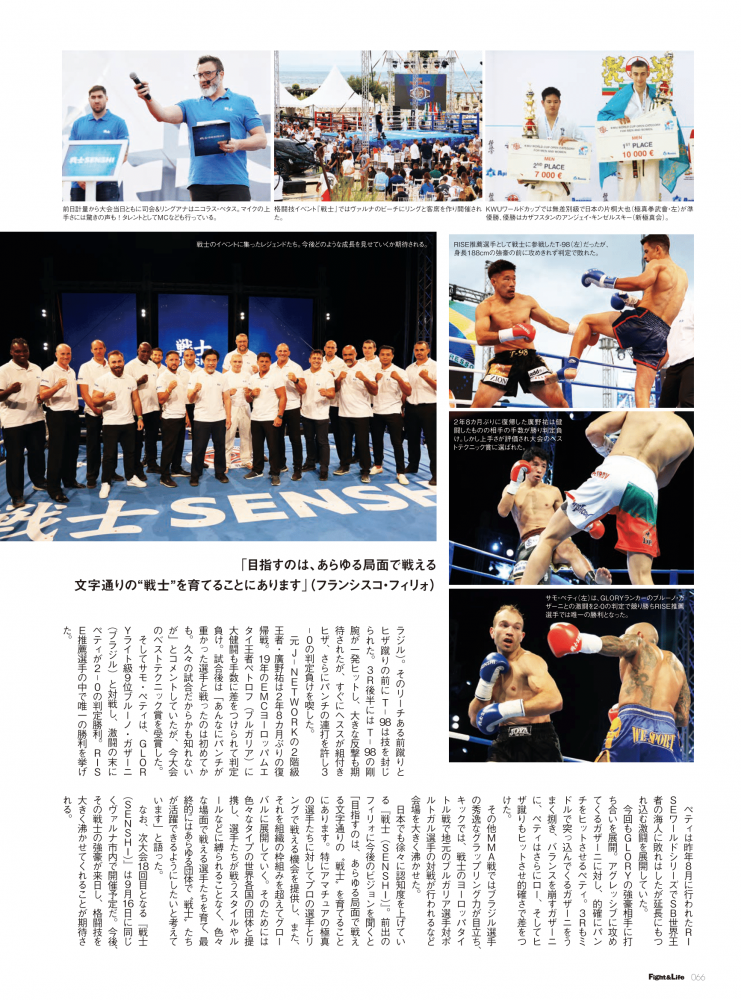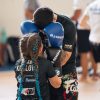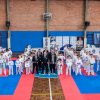Fight&Life – ファイト&ライフ magazine once again covered our events. Here is the article by Takuji Yoshikura
A Kyokushin karate summer camp with training sessions in kickboxing and kudo. 1200 participants gather! RISE-promoted fighters take part in the martial arts tournament SENSHI
戦士 What does KWU SENSHI aim to achieve!?
For about a week from July 2nd to July 9th, the Kyokushin Karate KWU Senshi International Summer Camp brought together over 1,200 karateka and martial artists in Kamchia, in the suburbs of Varna, Bulgaria. Among them, there were legends from various martial arts disciplines, including Kyokushin Karate, Daido Juku, kickboxing, and MMA, who shared their techniques and skills during special training sessions, turning the camp into a truly prestigious and remarkable event.
This summer training camp in Bulgaria gathered 17 legends from the world of martial arts.
From Daido Juku – the president Kenichi Osada.
From the kickboxing stage – Peter Aerts, Ernesto Hoost, Albert Kraus, Andy Souwer, Semmy Schilt.
In Kyokushin karate, first from Brazil – the 1999 Kyokushin karate world champion who also competed in K-1, Francisco Filho, and Ewerton Teixeira, who became Kyokushin karate world champion in 2007, as well as Glaube Feitosa and Andrews Nakahara who starred both in K-1 and in Kyokushin karate.
From the Czech Republic – Jan Soukup, 2nd at the 2007 World Open Karate Tournament.
From Georgia – the 2011 Kyokushin karate world champion Tariel Nikoleishvili.
From Bulgaria – the 2015 Kyokushin karate world champion Zahari Damyanov.
From Australia – Sam Greco, who fought in K-1 as well.
And from Japan – the 1990 winner of the All Japan Kyokushin Tournament, Akira Masuda; Ryu Narushima, who conquered the All Japan Weight Tournament 3 times; 2001 K-1 Japan GP champion Nicholas Pettas, who also competed in kyokushin karate. They all personally lead training sessions.
Until now, KWU (Kyokushin World Union) has been conducting large-scale Kyokushin karate training camps here in Bulgaria, but this time it was organized and hosted by KWU SENSHI, which was established this year.
KWU SENSHI also hosts the large-scale martial arts event 戦士 SENSHI; this is why this training camp went beyond the framework of Kyokushin karate.
So why do such large-scale training camps continue to be organized in Bulgaria every year? I spoke to Francisco Fihlo, the KWU SENSHI representative for Latin America, who served as the chief instructor at this training camp.
“This is the 17th summer training camp. KWU SENSHI is a separate organization from the KWU (Kyokushin World Union), and its board structure and activities are different, but they share the same slogan that the KWU has upheld ever since its establishment in 2012 – “Unite Kyokushin in one”. Therefore, here in Kamchiya, Bulgaria, where the facilities and environment are as good and welcoming as ever, and the reception system is well-established, the organizers give an opportunity for people from diverse backgrounds to exchange knowledge about karate techniques and their respective cultures, breaking down barriers related to nationality, culture, religion, age, gender, and organizational affiliations.” – Fihlo explained.
Fihlo and the other instructors from various disciplines divided into groups and provided instructions covering everything from basics to practical application of techniques at various locations, such as the beach, the gymnasium, and a football pitch.
Ryu Narushima, who, despite being in the lightweight division, competed and excelled even in open-weight tournaments, showed techniques, starting from warm-up exercises and going on to the fundamentals of Kyokushin karate and even methods to minimize the damage from incoming strikes while defeating your opponent, showcasing the skill to overcome bigger opponents though being smaller.
Having had experience both in K-1 and in Kyokushin karate, Glaube Feitosa taught the difference between punching in the face barehanded and with gloves. The participants listened to him with great interest and, following his instructions, engaged in repetitive practice.
Peter Aerts, Ernesto Hoost, and Nicholas Pettas explained kickboxing techniques in an easy-to-understand manner, and the president of Daido Juku, Mr. Osada, taught the secrets behind his formidable punches which made him famous as “the Hitman”, as well as some throwing techniques.
Akira Masuda taught some fundamental defense and counterattack techniques of Kyokushin karate and, in addition, as a practical combat strategy beyond the constraints of competitive rules and with the aim of returning to the origin of Kyokushin karate as a martial art, he also explained some joint lock techniques from the technical manual of its founder, Masutatsu Oyama – “The Secrets of Kyokushi Karate”. He taught how to handle situations when one has already been grabbed and explained techniques such as headbutts and throws depending on the circumstances.
Just as the organization bears the name SENSHI (Warrior), the goal is to cultivate “warriors” who bear the spirit of martial arts and the ability to handle any situation as individuals who practice kyokushin karate. And the participants have undoubtedly come a little bit closer to that goal.
When asked about the future vision of this training camp, Fihlo said: “It is already the largest in the world of its kind, but we aim further to increase the number of participants from various countries worldwide and enhance the quality of this training camp as a place for international exchange. Moreover, not as just a mere exchange platform, but also, though I cannot reveal details yet, we wish to introduce new initiatives which will make learning kyokushin karate here lead to a contribution to a global society in the very sense of this expression.”
At the morning practice on the 8th, all participants engaged in kyokushin karate sparing. During the sparing session, the 2007 World Championship final confrontation between Brazil’s Teixeira and Czech Republic’s Soukup repeated again. Furthermore, there was a sparring between the world champions Teixeira and Nikoleishvili. It became a passionate karate exchange beyond national borders.
The Kyokushin Karate World Cup and the Martial Arts Tournament “SENSHI”
During the international training camp, on 5 July, the “KWU World Cup Open Category 2023” brought together participants from 25 countries worldwide, and on the 8th, the martial arts tournament 戦士 SENSHI was held, both events generating a great deal of excitement.
In the open-weight category of the KWU World Cup, Daiya Katagiri (Kyokushin Kenbukai) participated in Japan and advanced to the finals. He engaged in fierce battles that went into overtime with the physically bigger overseas competitors and even achieved a victory by ippon.
In the finals, Katagiri struggled against the fast low kicks and knee kicks of the tall Anjey Kinzerskiy (Shinkyokushinkai) from Kazakhstan. He threw fewer strikes, perhaps due to the damage sustained from previous bouts. Katagiri did put up a fight despite taking hits but eventually fell to his knees and lost by ippon, ending up as the runner-up. The winner, Kinzerskiy received the Best Technique Award.
Furthermore, on the 8th of July, the 戦士 SENSHI tournament was held in Bulgaria’s resort town, Varna, where a ring and spectator seats were set up on the beach. A total of 18 matches in kickboxing and MMA were organized with a strong line-up of champion-class fighters from all over the world.
From Japan, three players promoted by RISE took part in the event – former Rajadamnern Stadium super welterweight champion nicknamed “the Muay Thai Gorilla”, T-98, as well as Samo Petje and Yu Hirono.
RISE’s representative Takashi Ito also accompanied them to Bulgaria. As a reason for recommending these 3 fighters, he said: “All three of them suffered losses in their last matches, and this will become a comeback fight for them. I want them to gain confidence through this overseas visit. They are all fighters capable of delivering great matches.”
T-98’s opponent was 188 cm tall Muay Thai world champion Marcio Jesus (Brazil). However, before his long-reach front kicks and knee kicks, T-98 found his techniques blocked. In the second half of the 3rd round, T-98’s strong arm landed a hit, raising expectations for a significant counterattack, but he soon let Jesus clinch and then deliver a knee kick, followed by a series of punches resulting in a 3-0 decision loss.
Former J-NETWORK champion in two weight divisions, Yu Hirono made a comeback after 2 years and 8 months. He put up a great fight against EMC European Muay Thai champion Petrov (Bulgaria), but the difference in the number of strikes led to a decision loss. “This might be the first time I’ve fought with a fighter with such powerful punches. It could be because it was my first match in a while, though”, commented he after the match. However, he received the Best Technique award of the tournament.
Samo Petje confronted Bruno Gazani (Brazil), ranked 9th in GLORY’s lightweight division, after an intense battle won by a 2-0 decision. He was the only one of the RISE fighters to achieve a victory.
In last year’s RISE World Series held in August, Petje was defeated by the SB World Champion Ono Kaito, but nevertheless, he put up a fierce fight that went into overtime.
This time again, Petje engaged in an intense exchange of strikes against a tough opponent from GLORY. He countered Gazani’s aggressive attacks with precise punches. In the 3rd round, Petje skilfully dealt with Gazani’s mid-range rushes, disrupting his balance. He managed to land some low kicks and knee kicks, making the difference with his precision.
In the MMA matches, the excellent grappling skills of Brazilian fighters stood out, and in kickboxing, there was a spectacular showdown between a local Bulgarian fighter and a Portuguese fighter which created a great deal of excitement at the venue.
The 戦士 SENSHI tournament has also been gradually gaining popularity in Japan. When asked about the future vision of the tournament, Fihlo replied: “Our goal is to nurture true “warriors” in the literal sense of the word. We particularly aim to provide amateur kyokushin fighters with opportunities to compete with professional fighters in the ring and to expand this on a global scale beyond the framework of organizations. For this purpose, we plan to collaborate with various types of organizations from all over the world, allowing fighters to develop without being bound by the restrictions of styles or rules so that they can fight in various scenarios. Ultimately, we want these “warriors” to succeed and excel in every organization.”
The next tournament – the 18th edition of 戦士 SENSHI – is scheduled to take place on 16 September, again in Varna. We hope that in the near future, some of those powerful SENSHI fighters will visit Japan, adding great excitement to the world of martial arts.







































